As educators, you may have well encountered the eye rolls and sighs accompanying the mere mention of math in the classroom. It can be disheartening, yes. But, what if we could transform this aura of dread into an atmosphere of excitement and curiosity?
The goal? Build a classroom where math is not confined to the pages of a textbook but is an engaging adventure that sparks creativity and problem-solving skills.
In this blog, you’ll learn 23 effective math teaching strategies to engage your students in math lessons, revolutionizing your math teaching experience.
Ready to dig in? Let’s get started.
The Top 4 Most Common Challenges in Math Lessons
To all math teachers looking for more effective math teaching strategies reading this article, do you agree?
1. Lack of Interest
In the perpetual battle to capture students’ attention, math often finds itself on the losing side. The pervasive belief that math is either too dull or too complicated creates a significant hurdle to math teachers.
Addressing the Challenge:
- 🔍 Innovation: Infuse lessons with creative elements using interactive tools to transform math into a captivating narrative.
- 🌐 Relevance: Showcase real-world applications to illustrate the practical and exciting aspects of mathematical concepts.
Our recommendation: Try interactive classroom teaching tool like ClassPoint to infuse interactive quizzes and gamification in your math lessons.
2. Limited Relevance
One of the common questions students often ask is, ‘When will I ever use this in real life?’ It is crucial to bridge the gap between abstract mathematical concepts and their practical applications.
Addressing the Challenge:
- 🎯 Connection Points: Introduce engaging examples that demonstrate the real-world significance of mathematical understanding.
- 🚀 Hands-On Learning: Utilize experiments and projects to bring math out of the textbook and into practical scenarios.
Our recommendation: Get students to solve math equations related to real-world examples and case studies using interactive tools like Drag and Drop to make real-world learning more fun.
3. Fear of Failure
Mathematics anxiety is a formidable foe in the classroom. The fear of making mistakes can paralyze students, hindering their ability to explore and learn.
Addressing the Challenge:
- 🤝 Supportive Environment: Foster a classroom culture that encourages risk-taking and views mistakes as valuable learning opportunities.
- 🌈 Positive Reinforcement: Celebrate small victories and progress, emphasizing the growth mindset over perfection.
Our recommendation: Try positive reinforcement by awarding stars to your students every time they solve a math problem, no matter how small it is!
4. Passive Learning
Traditional teaching methods can unintentionally foster passive learning, turning students into passive recipients rather than active participants.
Addressing the Challenge:
- 🔄 Interactive Strategies: Incorporate games, discussions, and collaborative activities to engage students actively.
- 🧠 Critical Thinking: Encourage students to question, analyze, and discuss mathematical concepts rather than passively receiving information.
Our recommendation: Try incorporating these easy-to-make PowerPoint games (with ready templates) in your next math lesson!
Understanding and addressing these challenges is the first step toward creating a math classroom that inspires curiosity and active participation.
In the subsequent sections, we’ll explore effective math teaching strategies to tackle each of these hurdles head-on, transforming math lessons from routine to remarkable.
21 Proven Math Teaching Strategies that Can Really Engage Your Students
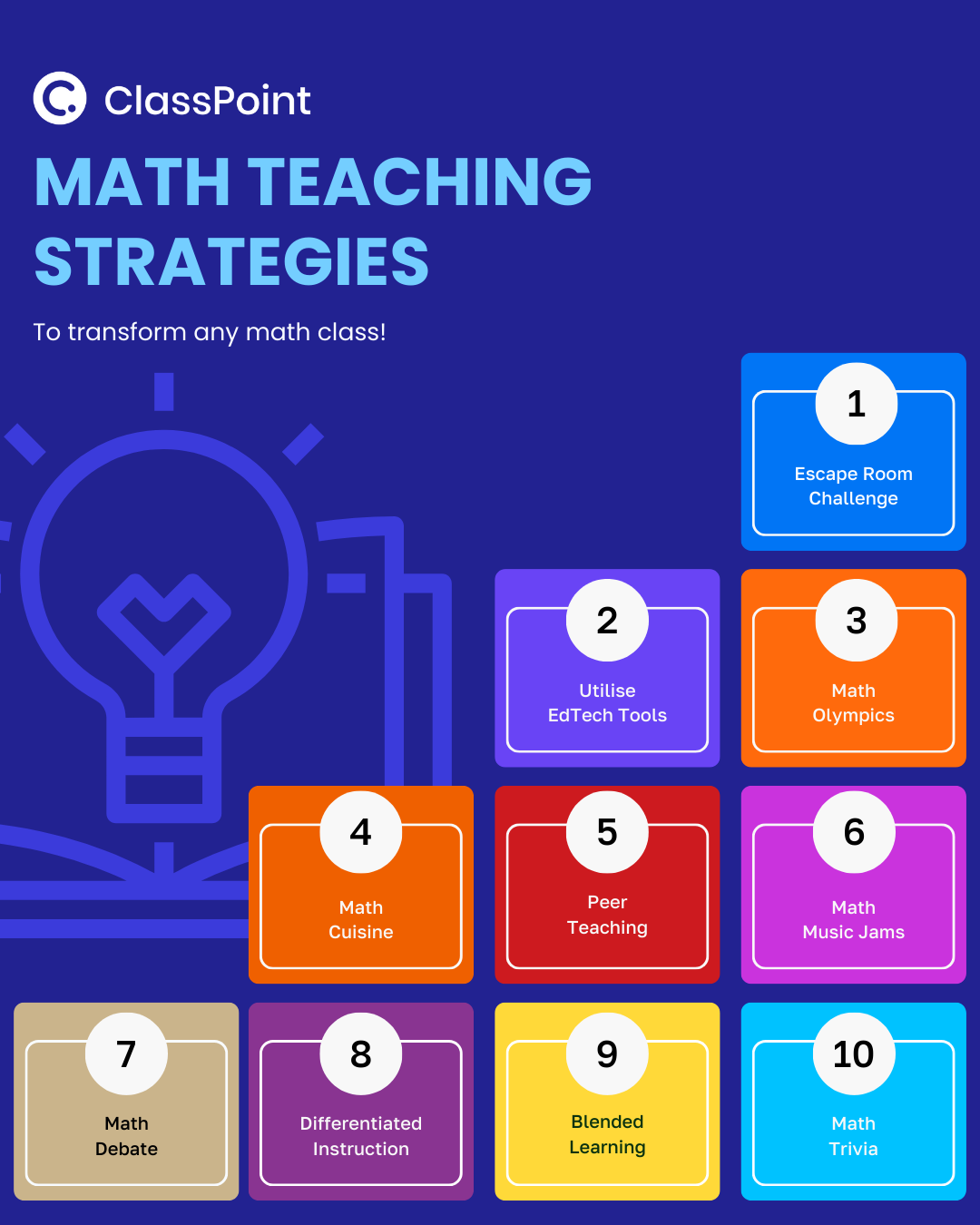
1. Escape Room Equations
What it is: Transform your classroom into an escape room, where students solve math puzzles to “unlock” clues and progress. This immersive math teaching strategy easily turns learning into an exciting adventure.
How to do it: Create math-based puzzles and challenges that students must solve collaboratively. Tailor difficulty levels to the class and gradually increase complexity as students advance.
Pro Tip: Use Drag and Drop to add a layer of interactivity to your math puzzles and challenges. Try these 8 different ways to conduct Drag and Drop lessons.
2. Math Mysteries
What it is: Effective math teaching strategies hinge on engaging students, and the secret for success lies in the element of mystery. Introduce a detective element to math problem-solving. Craft scenarios where students play the role of math detectives deciphering clues and solving mysteries.
How to do it: Develop narrative-based math problems that require critical thinking. Provide clues and guide students through the investigative process, promoting both deductive reasoning and mathematical application.
Don’t be afraid to utilise AI tools like ChatGPT for ideas generation. Here’s one example generated by ChatGPT:
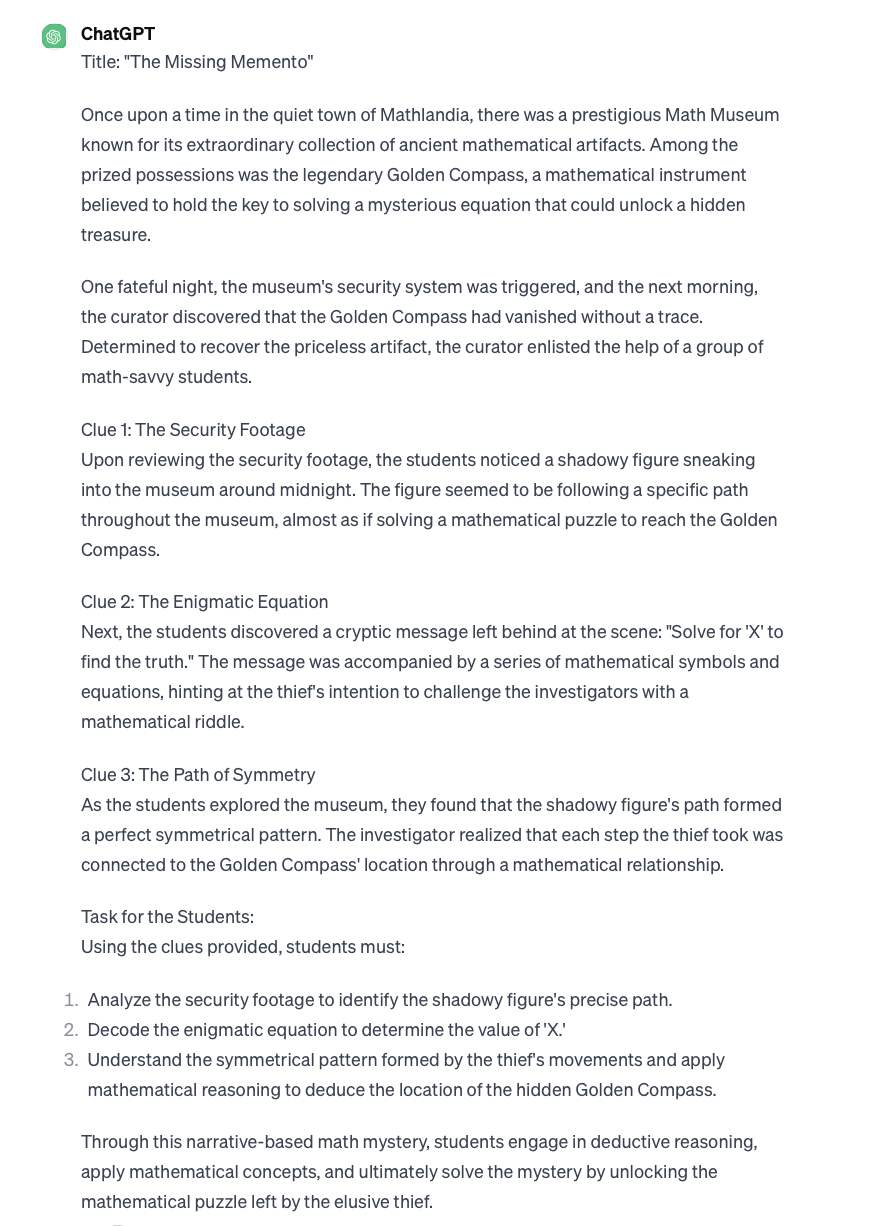
Pro Tip: Here are 100 ways you can utilise ChatGPT in your classroom.
3. Tech-Powered Challenges and Quizzes

What it is: Embrace educational technology to infuse excitement into math lessons. Utilize interactive apps, online platforms, and gamified tools that turn learning into a tech-driven adventure.
How to do it: Explore interactive teaching tools and math-oriented apps and platforms suitable for your students’ age and proficiency levels. Incorporate interactive elements such as quizzes and games, making learning engaging and personalized.
Check out interactive AI quiz maker like ClassPoint AI and AI Math Tutor like MATHia, Personalised Math Teaching AI assistant like DreamBox, Math Solutions Coach like Wolfram Alpha, these useful ChatGPT alternatives, as well as these 18 classroom apps recommended by experts.
4. Real-World Math Ventures
What it is: Connect math theories to tangible, real-world experiences and applications. Take students outside the classroom to explore how mathematical concepts are applied in everyday life. Or teach by providing firsthand insight to students within the classroom.
How to do it: Organize field trips, invite guest speakers, or collaborate with local businesses to showcase real-world math applications. Encourage students to document their findings and present their discoveries to the class. Alternatively, invite guest speakers from math-related professions to share their experiences.
5. Math Art Gallery

What it is: Marry creativity and math by turning the classroom into an art gallery. Have students create artwork that visually represents mathematical concepts.
How to do it: Assign each student or group a specific math topic. They can use various art mediums to showcase the beauty of math through visual representation. Host a class gallery walk to discuss and appreciate each piece.
6. Math Olympics
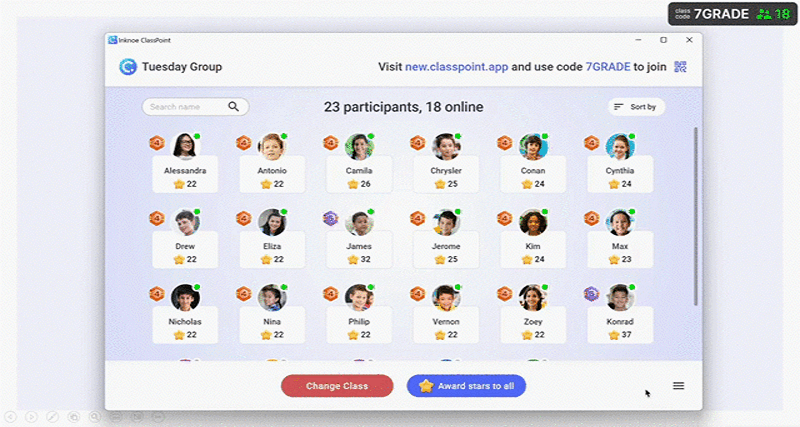
What it is: You cannot go wrong in using gamification in your math teaching strategies. Infuse friendly competition into math lessons with a Math Olympics. Students compete in teams or individually, solving math challenges and puzzles to earn medals.
How to do it: Organize a series of math challenges with varying difficulty levels. Create teams, assign point values to each challenge, and encourage a collaborative yet competitive spirit. Award medals or certificates to the winning participants.
Pro Tip: Easily run a Math Olympics in class by grouping students and rewarding those on the leaderboard.
7. Math in Motion

What it is: Harness the power of movement to make math physically engaging. Incorporate activities where students use their bodies to represent mathematical concepts.
How to do it: Design exercises like human number lines or geometric shape charades. Encourage students to physically interact with math problems, fostering a kinesthetic connection to abstract concepts.
8. Math Storytelling
What it is: Explore the narrative side of math by incorporating storytelling into lessons. Develop math-related stories or use literature that embeds mathematical concepts.
How to do it: Integrate storytelling during lessons to explain mathematical concepts or problem-solving scenarios. Encourage students to create their own math stories, fostering a connection between narrative structure and mathematical reasoning.
9. Math Cuisine

What it is: Combine the love of food with math by incorporating cooking or baking activities. Use recipes and measurements to reinforce mathematical concepts.
How to do it: Choose recipes that involve measurements, fractions, and conversions. Have students follow the instructions, measure ingredients, and adjust portions if needed. This hands-on approach makes math tangible and delicious.
Pro Tip: Use ClassPoint's annotation tools to annotate on food recipes directly within PowerPoint while you are presenting.
10. Peer Teaching Workshops
What it is: Sometimes the best math teaching strategies do not involve teachers as the active players in the equation. Try fostering a collaborative learning environment by having students become teachers. Organize peer teaching workshops where students explain mathematical concepts to their classmates.
How to do it: Assign topics to small groups and give them time to prepare short teaching sessions. Each group presents their topic, encouraging discussion and questions from their peers. This approach reinforces understanding through teaching and active engagement.
Pro Tip: Divide your students into groups using ClassPoint's Grouping feature and randomly select students to share their ideas using Name Picker.
11. Math Scavenger Hunt
What it is: Transform learning into an adventurous quest by organizing a math scavenger hunt. Create a series of math-related clues that lead students to discover solutions hidden around the school or classroom.
How to do it: Design clues that require solving math problems to unveil the next location. Incorporate a mix of difficulty levels and encourage collaboration as students work together to decipher clues and unlock the final destination.
Check out other classroom gamification methods you can use to better engage with your students.
12. Math Puzzles and Riddles Day
What it is: Designate a day solely for exploring math puzzles and riddles. Present a collection of intriguing mathematical puzzles that challenge students’ problem-solving skills as part of your math teaching strategies.
How to do it: Curate a selection of puzzles and riddles suitable for your students’ grade level. Dedicate class time for students to tackle these brain-teasers individually or in groups. Discuss solutions collaboratively, fostering a supportive and inquisitive atmosphere.
13. Math Music Jams
What it is: Integrate music into math lessons to create a harmonious learning experience. Explore the mathematical principles behind rhythms, patterns, and even the physics of sound.
How to do it: Incorporate music with mathematical significance into lessons. Discuss the mathematical concepts found in musical patterns, beats, and scales. Encourage students to create their own math-inspired tunes, linking creativity with mathematical understanding.
14. Interactive Whiteboard Challenges
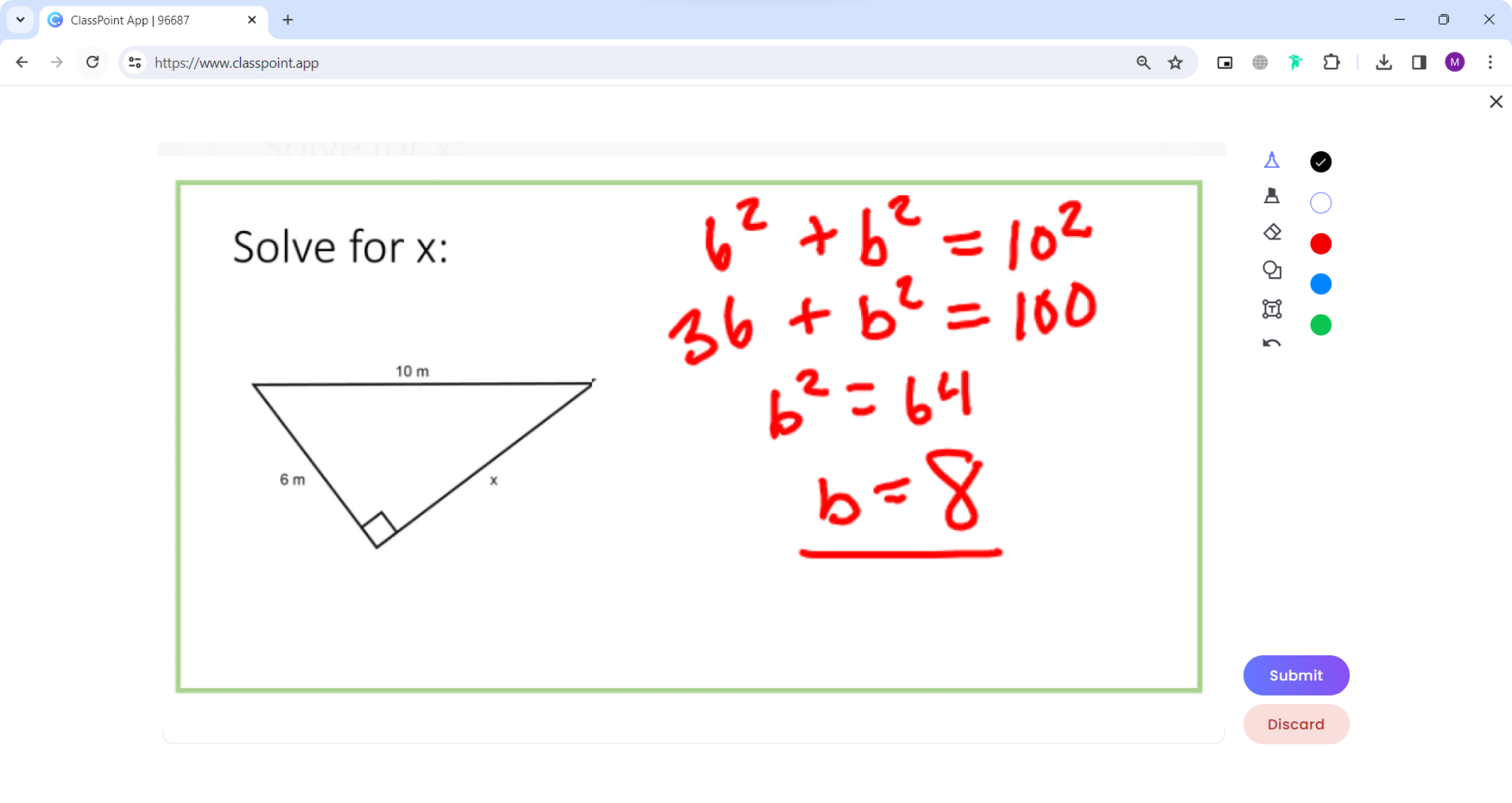
What it is: Utilize interactive whiteboards to engage students in dynamic math challenges. Transform the whiteboard into an interactive space for collaborative problem-solving.
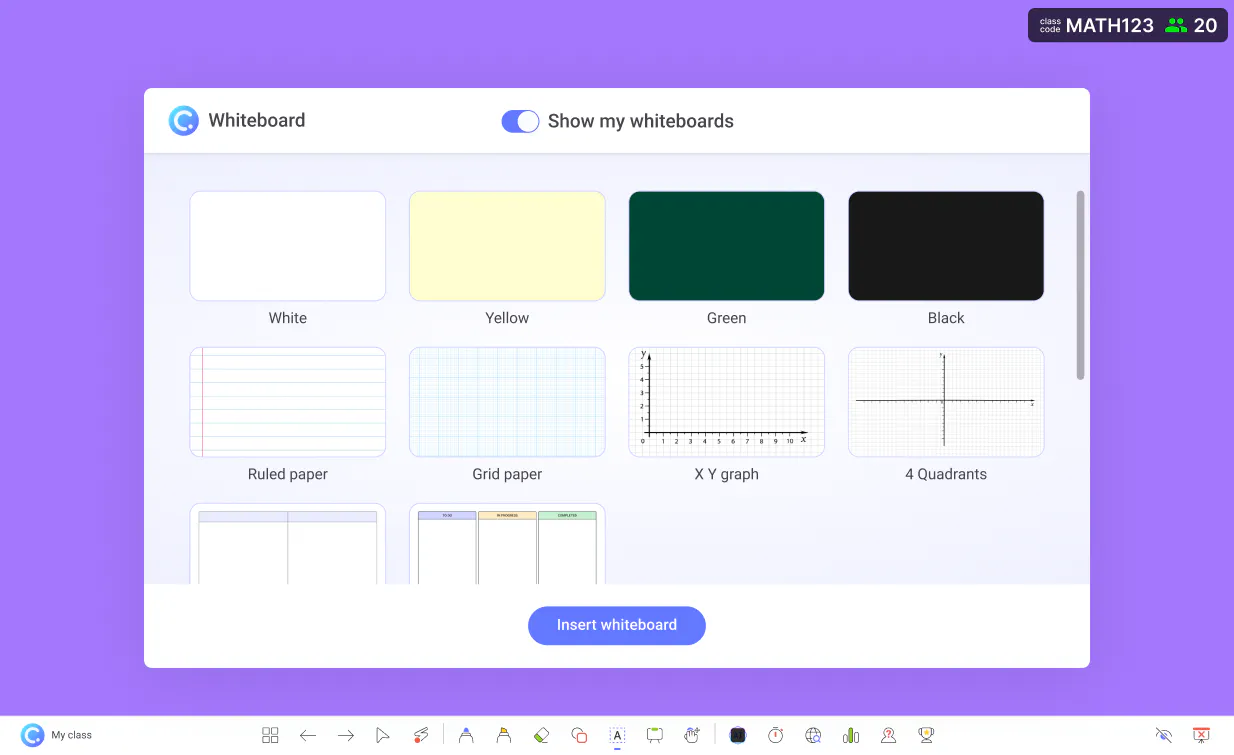
How to do it: Display math problems on the interactive whiteboard and invite students to solve them collectively. Use interactive features to draw diagrams, annotate solutions, and encourage active participation. This hands-on approach enhances engagement and interaction.
Pro Tip: Try these wide range of customizable math whiteboards from graph paper to grid paper in PowerPoint for your next class.
15. Math DIY Projects
What it is: Tap into students’ creativity by assigning do-it-yourself (DIY) math projects. Encourage them to create physical models, visual aids, or interactive displays related to mathematical concepts.
How to do it: Assign specific topics or concepts for students to showcase through DIY projects. Provide guidelines for materials, presentation, and ensure each project includes an explanation of the mathematical principles demonstrated.
16. Math Debate Club
What it is: Foster critical thinking and communication skills by organizing a Math Debate Club in the classroom. Encourage students to debate mathematical concepts, solutions, or even the relevance of specific mathematical theories.
How to do it: Assign debate topics related to the current curriculum or intriguing mathematical dilemmas. Divide the class into teams and allow time for research and preparation. Engage in lively debates where students defend their perspectives using logical reasoning.
Pro Tip: Try these 8 recommended mindmapping tools to connect your students' ideas together.
17. Math Comic Strip Challenge

What it is: Running out of math teaching strategies to engage with your students? Why not try humor? Infuse humor and creativity into math lessons by having students create comic strips that illustrate mathematical concepts or problem-solving scenarios.
How to do it: Provide guidelines for the creation of math-themed comic strips, including a requirement to incorporate specific mathematical concepts. This activity not only reinforces understanding but also allows for artistic expression and storytelling.
18. Differentiated Instruction in Mathematics
What it is: Differentiated learning involves teaching by providing personalised experience to students, acknowledging the diversity of learning styles in your class. Tailor your teaching methods to accommodate visual, auditory, and kinesthetic learners, ensuring that every student has an avenue for comprehension.
How to do it: Provide a spectrum of challenges within each lesson. Cater to students of different proficiency levels by incorporating both fundamental and advanced problems. This approach keeps every learner engaged and motivated.
Hear what this 20-year education specialist has to say in executing Differentiated Learning effectively in the classroom. Try these 25 Differentiated Learning strategies recommended for modern classrooms.
19. Utilizing Formative Assessment Strategies
What it is: Formative assessments are assessments that are conducted midway during a lesson or throughout a semester to assess student knowledge on a particular topic. And any successful math teaching strategies must incorporate these assessments.
How to do it: Use quizzes, polls, and class discussions to identify areas that require reinforcement or clarification. Adapt your teaching based on formative assessment results. If a significant number of students struggle with a particular concept, revisit and reinforce it before moving forward.
Have you tried these 5 math formative assessments that have been proven to work for teachers? Check out these 30 formative assessment questions inspired by Bloom's Taxonomy.
20. Encouraging Collaborative Learning

What it is: Foster collaboration by assigning group problem-solving tasks or projects. Encourage students to discuss and approach challenges collectively, promoting teamwork and peer learning.
How to do it: Implement project-based learning ideas or initiatives to get students working in groups. This not only helps reinforce understanding but also enhance the students’ grasp of the material.
21. Emphasizing Critical Thinking Skills
What it is: Incorporate Socratic questioning to stimulate critical thinking. Pose open-ended questions that require analysis, interpretation, and justification, encouraging students to explore the “why” behind mathematical solutions.
How to do it: Organize problem-solving workshops that challenge students to tackle complex issues, or quizzes and assessments based on Bloom’s Taxonomy. Guide them through the process of breaking down problems into manageable steps, fostering analytical skills.
Pro Tip: Generate math quizzes and assessment questions automatically using ClassPoint AI, the market leading AI quiz generator that generates questions based on your PowerPoint slides and Bloom's Taxonomy levels.
22. Math Blended Learning
What it is: Similar to hybrid learning, blended learning combines traditional face-to-face instruction with digital learning. But blended learning is more than just a teaching format, it is a well-designed teaching pedagogy made to maximize learning beyond the confines of traditional classrooms through these 5 different models.
How to do it: Conduct a pre-class math quiz online or share relevant materials with your students and discuss the findings and answers during class. You can also conduct additional math quizzes or even scavenger hunts during class to further reinforce new math concepts.
23. Math Trivia

What it is: Engage your students in an exciting math trivia showdown, encouraging friendly competition with their peers while learning math!
How to do it: Use a PowerPoint trivia template or create your very own math trivia using these gamification elements to instantly transform your classroom into a game arena where students don their metaphorical shining armor, prepared for an exhilarating battle of mathematical prowess.
By integrating these recommended math teaching strategies into your teaching approach, you not only create an engaging and supportive learning environment but also equip your students with the skills and mindset needed for success in mathematics.
Food for Thought
In education (not just in math), making the extra effort in turning the mundane to the extraordinary truly is a rewarding deed.
As we delved into 23 math teaching strategies aimed at engaging students in math lessons, it became evident that the key to making math enjoyable is not a one-size-fits-all solution. Instead, it lies in tailor-fit strategies specifically designed to cater to various classrooms and students alike.
As intimidating as math can seem, giving an extra push to how it’s delivered can turn every math lesson into a lifelong appreciation for the beauty of numbers. Here’s to making math not just a subject, but an enduring journey of intellectual growth and fascination!
Don’t forget to share this article with other teachers if you find it insightful!
